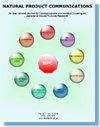Multifaceted Chemico-Pharmacological Insights into Cynometra ramiflora L.: Unveiling its GC-MS, Cytotoxic, Thrombolytic, Anti-Inflammatory, Antioxidant, Anti-Diarrheal, Hypoglycemic, and Analgesic Potentials
IF 1.4
4区 医学
Q4 CHEMISTRY, MEDICINAL
引用次数: 0
Abstract
Objective: This study aimed to comprehensively evaluate the chemico-pharmacological properties of methanolic extractives derived from Cyanometra ramiflora leaves, encompassing a spectrum of activities including cytotoxic, thrombolytic, membrane-stabilizing, antioxidant, antidiarrheal, hypoglycemic, and analgesic effects. Methods: Phytomolecules were identified using Gas Chromatography-Mass Spectrometry (GC-MS), while antioxidant activity was assessed using 2,2-diphenyl-1-picrylhydrazyl (DPPH) and total phenolic content tests. Cytotoxicity was determined through the brine shrimp bioassay, while thrombolytic activity was evaluated via clot lysis assays, and membrane-stabilizing effects were investigated for potential anti-inflammatory properties. In-vivo experiments using mice were conducted solely with the methanolic extract to assess central and peripheral analgesic, hypoglycemic, and antidiarrheal properties. Results: The presence of 47 compounds in the methanolic extract, with tetratriacontyl pentafluoropropionate (9.25%), pentatriacontane (8.75%), and 2-methylhexacosane (5.9%) being predominant. The dichloromethane-soluble fraction exhibited the highest cytotoxicity, with a 50% lethal concentration (LCCynometra ramiflora L.的多方面化学药理学见解:揭示其 GC-MS、细胞毒性、溶栓、抗炎、抗氧化、止泻、降糖和镇痛潜力
研究目的本研究旨在全面评估从蓝花楹叶中提取的甲醇萃取物的化学药理特性,包括细胞毒性、血栓溶解、膜稳定、抗氧化、止泻、降血糖和镇痛作用。方法:使用气相色谱-质谱法(GC-MS)鉴定植物大分子,使用 2,2-二苯基-1-苦基肼(DPPH)和总酚含量测试评估抗氧化活性。通过盐水虾生物测定法测定了细胞毒性,通过血凝块溶解试验评估了血栓溶解活性,并研究了潜在的抗炎特性的膜稳定作用。仅使用甲醇提取物对小鼠进行了体内实验,以评估中枢和外周镇痛、降血糖和止泻特性。实验结果甲醇提取物中含有 47 种化合物,其中主要是五氟丙酸四叔聪酯(9.25%)、五三聪烷(8.75%)和 2-甲基六六六烷(5.9%)。二氯甲烷可溶部分的细胞毒性最高,50%致死浓度(LC50)为 11.05 微克/毫升。在溶栓活性试验中,石油醚和甲醇溶性馏分的溶解度均超过 50%。在低渗和热诱导条件下,苧麻的乙酸乙酯和二氯甲烷可溶性馏分可显著减少红细胞溶血。值得注意的是,与标准 EDTA(IC50 = 75.94 μg/mL)相比,甲醇可溶性馏分具有明显的抗氧化潜力,其 50% 抑制浓度(IC50)为 17.71 μg/mL。降血糖研究显示,600 毫克/千克的剂量可在 90 分钟内降低 63.73%的血糖,而轻微的止泻活性可在 4 小时内减少 37.5%的腹泻。在中枢和外周测试中均显示出显著的镇痛效果,外周测试中蠕动减少了 68.53%,90 分钟时的平均尾部浸泡时间为 5.38 秒。结论苧麻叶片有望成为多种药理活性的天然来源,包括细胞毒性、血栓形成、炎症、抗氧化、降血糖和镇痛作用。不过,建议进一步开展综合研究,以阐明其确切的作用机制,并分析苧麻植物的植物化学成分。
本文章由计算机程序翻译,如有差异,请以英文原文为准。
求助全文
约1分钟内获得全文
求助全文
来源期刊

Natural Product Communications
工程技术-食品科技
CiteScore
3.10
自引率
11.10%
发文量
254
审稿时长
2.7 months
期刊介绍:
Natural Product Communications is a peer reviewed, open access journal studying all aspects of natural products, including isolation, characterization, spectroscopic properties, biological activities, synthesis, structure-activity, biotransformation, biosynthesis, tissue culture and fermentation. It covers the full breadth of chemistry, biochemistry, biotechnology, pharmacology, and chemical ecology of natural products.
Natural Product Communications is a peer reviewed, open access journal studying all aspects of natural products, including isolation, characterization, spectroscopic properties, biological activities, synthesis, structure-activity, biotransformation, biosynthesis, tissue culture and fermentation. It covers the full breadth of chemistry, biochemistry, biotechnology, pharmacology, and chemical ecology of natural products.
Natural Product Communications is a peer reviewed, open access journal studying all aspects of natural products, including isolation, characterization, spectroscopic properties, biological activities, synthesis, structure-activity, biotransformation, biosynthesis, tissue culture and fermentation. It covers the full breadth of chemistry, biochemistry, biotechnology, pharmacology, and chemical ecology of natural products.
 求助内容:
求助内容: 应助结果提醒方式:
应助结果提醒方式:


